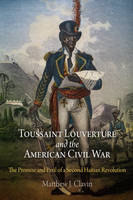
Toussaint Louverture and the American Civil War
University of Pennsylvania Press (Verlag)
978-0-8122-4205-8 (ISBN)
- Keine Verlagsinformationen verfügbar
- Artikel merken
At the end of the eighteenth century, a massive slave revolt rocked French Saint Domingue, the most profitable European colony in the Americas. Under the leadership of the charismatic former slave François Dominique Toussaint Louverture, a disciplined and determined republican army, consisting almost entirely of rebel slaves, defeated all of its rivals and restored peace to the embattled territory. The slave uprising that we now refer to as the Haitian Revolution concluded on January 1, 1804, with the establishment of Haiti, the first "black republic" in the Western Hemisphere.
The Haitian Revolution cast a long shadow over the Atlantic world. In the United States, according to Matthew J. Clavin, there emerged two competing narratives that vied for the revolution's legacy. One emphasized vengeful African slaves committing unspeakable acts of violence against white men, women, and children. The other was the story of an enslaved people who, under the leadership of Louverture, vanquished their oppressors in an effort to eradicate slavery and build a new nation.
Toussaint Louverture and the American Civil War examines the significance of these competing narratives in American society on the eve of and during the Civil War. Clavin argues that, at the height of the longstanding conflict between North and South, Louverture and the Haitian Revolution were resonant, polarizing symbols, which antislavery and proslavery groups exploited both to provoke a violent confrontation and to determine the fate of slavery in the United States. In public orations and printed texts, African Americans and their white allies insisted that the Civil War was a second Haitian Revolution, a bloody conflict in which thousands of armed bondmen, "American Toussaints," would redeem the republic by securing the abolition of slavery and proving the equality of the black race. Southern secessionists and northern anti-abolitionists responded by launching a cultural counterrevolution to prevent a second Haitian Revolution from taking place.
Matthew J. Clavin is Associate Professor of History at the University of Houston.
Introduction
Chapter 1. "The insurrection of the Blacks in St. Domingo": Remembering Toussaint Louverture and the Haitian Revolution
PART I. OPENING THE CIVIL WAR OF WORDS
Chapter 2. "He patterned his life after the San Domingan": John Brown, Toussaint Louverture, and the Triumph of Violent Abolitionism
Chapter 3. "Contemplate, I beseech you, fellow-citizens, the example of St. Domingo": Abolitionist Dreams, Confederate Nightmares, and the Counterrevolution of Secession
PART II. A SECOND HAITIAN REVOLUTION?
Chapter 4. "Liberty on the Battle-field": Haiti and the Movement to Arm Black Soldiers
Chapter 5. "Emancipation or Insurrection": Haiti and the End of Slavery in America
PART III. NATIONS WITHIN A NATION
Chapter 6. "Many a Touissant L'Overture amongst us": Black Identity
Chapter 7. "A Repetition of San Domingo?": Southern White Identity
Chapter 8. "Do we want another San Domingo to be repeated in the South?" Northern White Identity
Conclusion
Notes
Index
Acknowledgments
| Erscheint lt. Verlag | 12.11.2009 |
|---|---|
| Zusatzinfo | 10 illus. |
| Verlagsort | Pennsylvania |
| Sprache | englisch |
| Maße | 152 x 229 mm |
| Themenwelt | Geschichte ► Allgemeine Geschichte ► Neuzeit (bis 1918) |
| Geisteswissenschaften ► Geschichte ► Regional- / Ländergeschichte | |
| ISBN-10 | 0-8122-4205-X / 081224205X |
| ISBN-13 | 978-0-8122-4205-8 / 9780812242058 |
| Zustand | Neuware |
| Haben Sie eine Frage zum Produkt? |
aus dem Bereich


